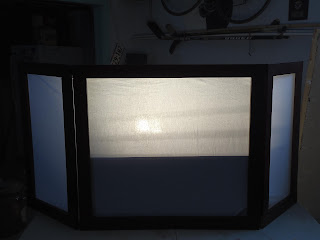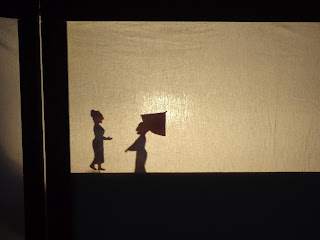 |
| Basic plans for a table-top shadow stage. |
The Plans
I developed the plans and measurements based on a working design by another theater company, one of which as soon as I find it again I will post it. The stage dimensions were larger than what I had wanted, so I took the liberty of adjusting the sizes to suit my needs.
Additionally, I found the idea of being able to fold the wings of the stage in to both protect the viewing area and to make the stage more portable to be a good idea. In both my plans and the plans of the theater company I found online, the wings fold over to completely cover one side of the viewing area. This helps make the stage transportable and protects the screen during transportation.
The Wood
I used couple of 1" by 4" boards that we happened to have lying around. I cut them to the measurements I had decided on earlier and sanded them to prepare the boards for staining.
Staining the wood helps out in several ways. First, the stain helps protect the wood from minor water damage and getting "dirty". The second reason is to cover up the dull look of new wood and give the shadow puppet theater a little more class.
 |
| This is the type of stain that I used; mostly because we had it and it was a color I could work with. |
 |
| The wood after the first coat... |
I ended up using three coats of stain on the wood frame. This allowed the actual color to become darker; effectively making a distinctive frame around what would later become a white screen.
After staining the wood, I used a clear Crystal Coat to help further protect the wood. While the additional coat gives the wood a shiny texture, it does help to protect the wood further in adverse weather. The Crystal Coat can be dulled using fine sandpaper, which I decided to use.
Construction
Using L brackets and hinges, I constructed the stage. For the wings, I used 2" flat L brackets while on the main screen, I used 3" flat brackets. Since the main screen will see the most pressure against it, I decided that the larger brackets would work perfectly.
Since the wood wasn't very thick, and most of the holes were near the edge, I needed to pre-drill a small hole where the screws would go. After that, I carefully attached the boards together; keeping in mind which boards would lay ontop of others.
The hinges were a little trickier. I wanted to make sure that the screen folded in on itself and, as such, had to make sure they were all facing the right direction. After ensuring that the hinges worked the way I wanted them to, I attached the hinges in the same way that I attached the "L" brackets.
 |
| The hinge and "L" brackets as previously discussed. |
The Screen
The screen is made of white cotton fabric. The fabric is thick enough so that it is not translucent but thin enough to allow the shadows to play nicely on the screen. The fabric was cut in one long piece and stapled to the frame as tight as possible.
Making the fabric tight helps to create a crisp shadow and, at the same time, helps to make sure that the shadow puppets do not bulge the screen out when they are placed up against it.
Finished Product
 |
| The shadow puppet stage with light behind it. |
 |
| The addition of a light block behind the screen gives the puppeteer a place to hold the shadow puppet and frames the screen |
The shadow puppet theater wasn't able to be used at the event is was planned to be out. So, instead of shoving it in the corner and digging it out later, I invited the rest of the Batty Puppetters to check out the stage and play around with it. The results were quite a sucess.
 |
| The shadow turn out perfectly for our purposes; here is a woman and a geisha talking to each other. |
 |
| A samurai. |
 |
| An example of mixing two shadow puppets; here a japanese devil mask sits ontop of a mountain range. |
Final Thoughts
While this stage was constructed with a single purpose in mind, it can be used for further activities of The Batty Puppeteers. Shadow puppets are very in period of the Society for Creative Anachronism, and I have no doubt that this stage will be used more than once. Because of its portability; we can take this anywhere we want to go. The only thing we really have to worry about is a light source.
Additionally, the completed shadow puppet stage can be used by children. The construction is strong enough to withstand most children so that isn't really a problem. A shadow puppet stage will also allow children to invent stories and tales so that they have something to do at events as well; something other than play with Monster High dolls.
In the future, I would like to use more medieval techniques of construction; either fitted joints or pegs to hold it all together. As this stage was a simple construction, I used metal bits that I probably wouldn't use in the far future. While I have never made joints to put two peices of wood together, I have used pegs and those are easy to do. Additionally, I would chose to make a leather hinge instead of using the metal ones again; simply for authenticity reasons.
Additionally, the shadow puppets themselves are currently made of cardboard. In the future, I would like to make thin leather puppets or laquered paper or parchment that are muli-jointed and painted. Leather puppets can be found in the Far East, and help add to the medieval aura around the stage and paper puppets are just as easy to find.


